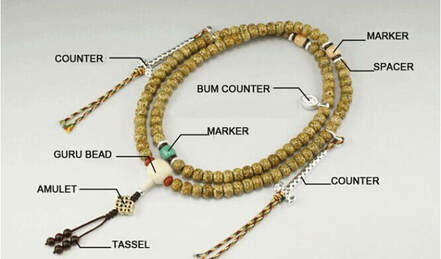Mala Teachings
A mala is made of beads, a guru bead, a tassel, and a string that holds them all together. Typically you will see 21, 27, and 108 bead malas. A guru bead may be quite lavish however for practice it will be simple and may even be identical to the other 108 beads. - from Bhakti House
|
(Image from buddhistmalas.com)
|
Teachings on the Mala from Guru Rinpoche
A Garland of 108 Roses The word mala (which is the proper term for the prayer beads used by Buddhists) is Sanskrit, and means "garland" or "roses." It may be no coincidence that the prayer beads used by Roman Catholics and Anglicans, among other religious groups, are called "rosaries." |
Of course, Buddhism predates Christianity and they are both outranked by the Hindus, who are thought to have originated the form of mala in use by Buddhists. One hundred and eight beads make up the Buddhist Mala. This is a significant number. There are 108 books containing the complete teachings of the Buddha Kanjur, for example.
Using your Mala
A mala made from seashells, earth, wood or seeds from trees, or fruit is meant to be used to accomplish peaceful sadhanas and peaceful action. A mala made from gold will accomplish expansive karmas. A red coral mala is best for accomplishing powerful sadhanas. A steel or turquoise is good for wrathful activity. A mala made from Dzi or other precious stones can be used to accomplish any of the karmic activities you are doing.
A mala made from Bodhiseed accomplishes all Dharmas. Malas of Bodhi tree wood accomplish peaceful karmas.
Beads made of stone are good for expansive practice. Beads made of medicine are good for wrathful practice. Malas with many different types of jewels are good for any practice. However, I suggest that you not attempt to create a mala with a lot of different beads on it because, unless you know which combinations are effective, you may cause a non-positive result.
It is said that a mala made from bodhiseed manifests limitless benefits for any form of practice, be it peaceful, expansive, powerful or wrathful.
The main Guru Bead may be composed of three beads, symbolizing the three Vajra states of being, the three kayas. The smallest bead on the outside should be blue, perhaps made of lapis. The colour blue symbolizes the unchanging mind of ultimate truth. The bead in the middle should be red, to symbolize Vajra speech, and the innermost bead should be white, to symbolize the Vajra body.
Your mala must be blessed by a Lama or your teacher and you should constantly bless your mala yourself by imbuing it with energy. You must put energy into your mala before counting recitations with it, to produce real benefit.
Your mala represents not only the form of the Deity but the speech of the Deity as well. For example, if you recite the hundred syllable mantra, the guru bead represents the syllable OM and the other beads represent the remaining syllables.
Use only the ‘left’ hand to count Mantras.
Whatever kind of practice you are doing, always be aware that the thumb is a vajra hook which hooks spiritual powers, deities and other blessings. It is also easier to move the beads with your thumb.
The following teachings have come straight from the mouth of Guru Rinpoche.
“If your mala has been repeatedly blessed by great Lamas, by your own teacher and by yourself as part of your deity practice, it should accompany you like your shadow. You keep the root samaya (highest tantric practice) of the Vajra mala by never letting it leave your body.
Never show your secret vajra mala to any other person. Never put your mala in other people’s hands. Do not pass it around or entrust it to the care of others. Never let your mala pass into the hands of a person who has broken his or her vows."
"Hold your mala only when doing Mantra recitation. Do not play or fumble with it nervously at other times. Do not perform divination on your mala or tally sums on it."
"Keep your mala private and have a humble attitude. Do not flash it around for others to notice. Never put it in a low place, and certainly never on the ground. Do not put beads on your mala that have no meaning and do not put beads on it for adornment’s sake."
"It is very important to protect your mala from contamination by non-virtuous persons. If it contacts the hands of a person who has committed any of the five heinous crimes, you will fail in whatever you try to accomplish."
"A mala that is incomplete or damaged should not be used. A mala with more or less than 108 beads is not fit to be used.”
These teachings were not given by Guru Rinpoche so that you would become so attached to your mala that you would not show it to others. These teachings were given because, as a Vajrayana practitioner, you need a consecrated mala to perform vajra recitations. The mala is viewed as the root deity with the entire assembly and mandala. As a Vajrayana practitioner, you take the mala as your source of refuge and thus achieve spiritual powers and blessings on an extraordinary, supreme level and not merely on an ordinary level. Therefore, you are instructed to rely on your mala in these ways.
Using your Mala
A mala made from seashells, earth, wood or seeds from trees, or fruit is meant to be used to accomplish peaceful sadhanas and peaceful action. A mala made from gold will accomplish expansive karmas. A red coral mala is best for accomplishing powerful sadhanas. A steel or turquoise is good for wrathful activity. A mala made from Dzi or other precious stones can be used to accomplish any of the karmic activities you are doing.
A mala made from Bodhiseed accomplishes all Dharmas. Malas of Bodhi tree wood accomplish peaceful karmas.
Beads made of stone are good for expansive practice. Beads made of medicine are good for wrathful practice. Malas with many different types of jewels are good for any practice. However, I suggest that you not attempt to create a mala with a lot of different beads on it because, unless you know which combinations are effective, you may cause a non-positive result.
It is said that a mala made from bodhiseed manifests limitless benefits for any form of practice, be it peaceful, expansive, powerful or wrathful.
The main Guru Bead may be composed of three beads, symbolizing the three Vajra states of being, the three kayas. The smallest bead on the outside should be blue, perhaps made of lapis. The colour blue symbolizes the unchanging mind of ultimate truth. The bead in the middle should be red, to symbolize Vajra speech, and the innermost bead should be white, to symbolize the Vajra body.
Your mala must be blessed by a Lama or your teacher and you should constantly bless your mala yourself by imbuing it with energy. You must put energy into your mala before counting recitations with it, to produce real benefit.
Your mala represents not only the form of the Deity but the speech of the Deity as well. For example, if you recite the hundred syllable mantra, the guru bead represents the syllable OM and the other beads represent the remaining syllables.
Use only the ‘left’ hand to count Mantras.
Whatever kind of practice you are doing, always be aware that the thumb is a vajra hook which hooks spiritual powers, deities and other blessings. It is also easier to move the beads with your thumb.
The following teachings have come straight from the mouth of Guru Rinpoche.
“If your mala has been repeatedly blessed by great Lamas, by your own teacher and by yourself as part of your deity practice, it should accompany you like your shadow. You keep the root samaya (highest tantric practice) of the Vajra mala by never letting it leave your body.
Never show your secret vajra mala to any other person. Never put your mala in other people’s hands. Do not pass it around or entrust it to the care of others. Never let your mala pass into the hands of a person who has broken his or her vows."
"Hold your mala only when doing Mantra recitation. Do not play or fumble with it nervously at other times. Do not perform divination on your mala or tally sums on it."
"Keep your mala private and have a humble attitude. Do not flash it around for others to notice. Never put it in a low place, and certainly never on the ground. Do not put beads on your mala that have no meaning and do not put beads on it for adornment’s sake."
"It is very important to protect your mala from contamination by non-virtuous persons. If it contacts the hands of a person who has committed any of the five heinous crimes, you will fail in whatever you try to accomplish."
"A mala that is incomplete or damaged should not be used. A mala with more or less than 108 beads is not fit to be used.”
These teachings were not given by Guru Rinpoche so that you would become so attached to your mala that you would not show it to others. These teachings were given because, as a Vajrayana practitioner, you need a consecrated mala to perform vajra recitations. The mala is viewed as the root deity with the entire assembly and mandala. As a Vajrayana practitioner, you take the mala as your source of refuge and thus achieve spiritual powers and blessings on an extraordinary, supreme level and not merely on an ordinary level. Therefore, you are instructed to rely on your mala in these ways.
How to Care for Your Prayer Beads
(These are just the 'traditional rules' for malas in the Buddhist communities. It is best to let the mala speak to you and guide you on how it would like to be treated. But if in doubt, these suggestions could be followed.)
- Never take/wear a mala into a restroom - either take the mala off or place it into a bag before entering.
- Never allow anyone to handle your mala(s) unless they are a teacher/clergy you respect, unless it is to have a broken set repaired.
- It is very appropriate to have a mala blessed by a monk/priest/guru etc.
- Never place your mala on the ground - unless you want to clear all the energy stored up in the mala (clearing it).
- Never set anything on top of your mala - always place the mala on top of anything that must be stacked.
- Always wear the mala with the tassel in the front and not behind your back - clergy wear them with the tassel behind rather than in front as a sign of being ordained.
- It is fine to wrap the mala around your wrist if you wish to wear them that way - but wear them on your non-dominate hand.
- When the mala is not in use or not being worn - it must be kept in its own bag, box, on a shrine or other storage place that is designated just for ritual objects (or specifically for the mala).
- Do not leave them sitting out on a table or hanging - unless it is to temporarily place it somewhere while you use a restroom and such.
- Only use one mantra per mala so that the mala only stores the energy of one mantra.

